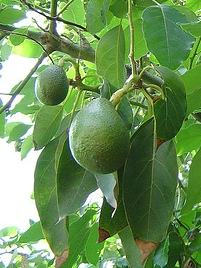The avocado (Persea americana) is a large fruit-bearing tree native to Central and South America. The avocado tree is classified in the Lauraceae family, which includes laurels and cinnamon, indicating its origins in humid tropical forests. Its commercial cultivation is extensive in various regions of the world, with Mexico being one of the main exporters, followed by countries like the Dominican Republic, Peru, Colombia, and Indonesia. This tree can reach about 20 meters (65 feet) in height under ideal conditions. Its trunk, somewhat straight, can achieve a diameter of 1 meter (about 3 feet) at 30 years of age. The bark of the stem and branches is notable for its grayish texture, thick, corky, and fissured. Its leaves are large, glossy, leathery, and elliptical to lanceolate in shape. They exhibit a dark green color, are glabrous and shiny on the upper side, and pubescent on the lower.
The flowers of the avocado tree are small, hermaphroditic, and light green in color. They appear in large numbers, organized in panicle-type inflorescences. The fruit, a pyriform or ovoid drupe, is known for its skin varying from green to brown and a creamy, slightly sweet pulp with a coloration ranging from olive green to cream. This pulp is notable for its oil content, which varies between 5 to 30%.
The fruits of the avocado tree are large, weighing up to a kilo (2.2 pounds), and contain a single, spherical, and sizable seed. An interesting characteristic of the avocado is that it must be harvested while still green and ripens after harvest, a process that occurs slowly. The avocado pulp is versatile in cooking, consumed raw, cooked, or preserved. It is often used in savory dishes like pâtés, guacamoles, soups, and salads, but is also delicious in sweet preparations, mashed or blended with sugar and milk, forming desserts or smoothies. Lemon, often used as a seasoning, accompanies the avocado in both sweet and savory preparations. Besides being calorific, the avocado is highly nutritious, rich in vitamins E, A, B, and monounsaturated fats. Its oil, similar to olive oil, is also extracted from the pulp.
Beyond its nutritional value, the avocado has medicinal applications and uses in cosmetology. Studies suggest its oil may be beneficial for skin and hair, and the fruit has been linked to cholesterol reduction and improved cardiovascular health. Historically, the avocado has also been used in cultural practices and rituals in its regions of origin.
There are three main subspecies of avocado tree, each with unique characteristics of adaptation and productivity: the Guatemalan (P. nubigena guatemalensis), the Antillean (P. americana americana), and the Mexican (P. americana drymifolia). These subspecies are intercrossable, giving rise to the modern varieties of avocado trees used in commercial orchards. The modern varieties are subdivided into groups A and B, a classification based on the pattern of flower opening. For effective pollination, it is essential to grow varieties from both groups together, as the male and female sexual organs mature at different times.
In landscaping, the avocado tree is valued for its dense foliage and generous shade, making it a popular choice for parks and large gardens. However, its large size and extensive root system require careful consideration regarding planting location to avoid damage to nearby structures. It is quite common to plant in residential domestic gardens, but care must be taken as its wood is fragile and prone to breakage during storms. Young plants are often grown in pots as indoor plants, positioned near sunny windows. They provide an elegant atmosphere and have rapid initial growth.
For successful cultivation, the avocado tree should be planted in a sunny location, in fertile, deep, drainable soil enriched with organic matter. Like many tropical fruit tree species, the avocado tree should be watered periodically. The tree adapts well to heat, but modern cultivars have shown adaptability to a wide range of climates, including high altitudes and frost resistance. Different varieties allow for year-round avocado harvesting.
For young avocado trees, balanced fertilization, rich in nitrogen, phosphorus, and potassium, along with micronutrients like zinc, manganese, and boron, is recommended. These elements are essential for plant development. As the tree matures, fertilization should be adjusted, prioritizing potassium, which is crucial for fruit quality and size. The application of organic fertilizer, such as compost or well-rotted manure, is also very beneficial, as it improves soil structure and water retention capacity, and provides nutrients gradually. Regular fertilization, preferably at the beginning of the growth season and after harvest, is important.
Pruning of the avocado tree is a crucial aspect of managing this fruit-bearing tree, especially when aiming to facilitate harvesting. Formative pruning, conducted in the first years of the tree’s life, aims to develop a strong, well-distributed branch structure, capable of supporting the fruit’s weight and allowing easy access during harvest. Ideally, an open shape, like a vase or cup, should be sought, removing central branches to allow light entry, reduce the final height of the plant, and improve air circulation inside the crown. This not only improves fruit quality and quantity but also reduces the incidence of diseases.
Maintenance pruning in subsequent years involves removing dry, diseased, or inward-growing branches, maintaining the desired shape of the tree. It’s important to prune at the appropriate time, usually after harvest, to avoid damaging the next cycle’s production and ensure plant health. Annual sprayings with Bordeaux mixture are important for preventing anthracnose and other fungal diseases, which cause fruit abortion and reduce shelf life. Plant propagation occurs both through seeds, which germinate easily, and commercially through grafting, a technique that ensures the replication of desired characteristics of the mother plant. The grafted avocado tree is precocious and begins to produce fruits between the 3rd and 4th year, potentially yielding between 200 to 800 fruits annually.


